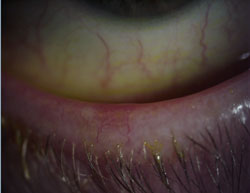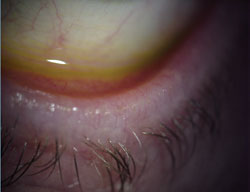New drugs, surgical techniques mitigate ocular surface disease
Physicians should consider more aggressive perioperative treatment of dry eye and blepharitis.
New topical agents — including antibiotics, anti-allergy agents and steroids — and off-label dosing protocols have been shown to improve the treatment of ocular surface disease.
Improved treatments for dry eye related to multifocal IOL implantation and LASIK have also yielded promising results.
Recent developments have enhanced the management of dry eye and blepharitis, especially in light of high patient expectations, David R. Hardten, MD, OSN Cornea/External Disease Section Editor, said.
 David R. Hardten |
“There’s been a lot more attention paid to perioperative management of dry eye and blepharitis this last year, especially as our patients have increased expectations for quality of vision and return of vision postoperatively,” Dr. Hardten said. “Now that we’ve improved a lot of the other aspects of the surgical process and procedure, and with more rapid recovery with cataract and lens implant surgery, especially with presbyopic IOLs, we’re paying more attention to blepharitis and dry eye pre- and postoperatively.”
Devices that provide sustained and controlled drug delivery would enhance treatment, especially for patients who are unwilling or unable to use eye drops, Dr. Hardten said.
“For some of the chronic problems, like dry eye, allergy, or even in some conditions where it may not be chronic but it’s a frequent enough occurrence that it’s a hassle, it would be nice to have longer-acting medications,” he said. “So far, it has been very difficult to standardize the release and delivery and the effectiveness of medications other than the typical once- or twice-a-day drop or ointment.”
Off-label azithromycin
Off-label use of AzaSite (azithromycin ophthalmic solution 1%, Inspire Pharmaceuticals) will allow major improvements in the treatment of meibomian gland dysfunction and blepharitis, Eric D. Donnenfeld, MD, OSN Cornea/External Disease Board Member, said. Topical azithromycin is currently approved for bacterial conjunctivitis.
“Meibomian gland dysfunction is as important as aqueous deficiency dry eye in ocular surface disease and has been grossly understudied and undertreated,” Dr. Donnenfeld said. “The next decade, I predict, will be the decade of meibomian gland dysfunction in blepharitis management to improve ocular surface disease and improve visual outcomes. [AzaSite] has really revolutionized the treatment of meibomian gland dysfunction. We’re now treating these patients with one drop a day and getting outstanding results.”
|
|
|
|
Off-label use of AzaSite (azithromycin
solution 1%, Inspire Pharmaceuticals) showed promising results in treating
blepharitis, as shown by images of the lid margin before (left) and after
treatment. AzaSite is currently approved for bacterial
conjunctivitis.
Images: Donnenfeld ED |
|
Azithromycin may be applied topically or massaged into the lids, Dr. Hardten said.
“A lot of patients have had good success with once-a-day AzaSite for blepharitis,” Dr. Hardten said. “We typically rub it into the eyelid margin, although some people use it as a drop and then massage the lid.”
Dr. Donnenfeld cited data presented in a poster at the 2009 Association for Research in Vision and Ophthalmology meeting showing that azithromycin significantly improved meibomian gland secretion.
Besivance (besifloxacin ophthalmic suspension 0.6%, Bausch & Lomb), a new topical antibacterial agent, is now approved to treat bacterial conjunctivitis. Iquix (levofloxacin ophthalmic solution 1.5%, Vistakon Pharmaceuticals) is approved for the treatment of susceptible gram-positive and gram-negative bacterial corneal ulcers.
Positive data on cyclosporine
Dr. Donnenfeld described study data, presented at the 2007 American Society of Cataract and Refractive Surgery meeting, on the effectiveness of Restasis (cyclosporine ophthalmic emulsion 0.05%, Allergan) in improving visual outcomes after multifocal IOL implantation. The prospective study included 28 eyes of 14 patients who underwent cataract extraction and multifocal IOL implantation. Patients did not have pre-existing dry eye. Patients received cyclosporine in one eye and artificial tears in the other eye, from 1 month before surgery to 2 months after surgery on the second eye.
At 2 months postop, patients in the cyclosporine group had better visual acuity and contrast sensitivity than those in the artificial tears group. In addition, patients who received cyclosporine had better conjunctival staining scores and tear breakup time than those who received artificial tears, Dr. Donnenfeld said.
He noted that phacoemulsification incisions and limbal relaxing incisions can diminish visual outcomes in patients undergoing cataract surgery when their eyes are also dry and their tear film is poor.
“If there’s any additional loss of contrast sensitivity due to a disrupted ocular surface, there’s going to be visual compromise that may be very unacceptable,” Dr. Donnenfeld said.
At the 2008 Association for Research in Vision and Ophthalmology meeting, Dr. Donnenfeld and colleagues presented data showing that cyclosporine in conjunction with the steroid Lotemax (loteprednol etabonate ophthalmic suspension 0.5%, Bausch & Lomb) safely and effectively treated dry eye.
The study included 118 patients randomized to receive loteprednol and cyclosporine or artificial tears and cyclosporine. Patients who received loteprednol and cyclosporine reported less stinging and had better ocular surface disease index scores than those who received artificial tears and cyclosporine, Dr. Donnenfeld said.
“There are no side effects that are visually significant associated with cyclosporine,” he said. “The only side effects that I have seen are the occasional burning and stinging. There are no wound healing problems, there’s no infection risk and there’s no cataract genesis or glaucoma.”
Reverse femtosecond side cut
New study results show how a 140· reverse side cut in femtosecond flap creation for LASIK preserved contrast sensitivity, sped the return of corneal sensation and minimized dry eye, Dr. Donnenfeld said. He and fellow researchers — OSN Refractive Surgery Board Member Kerry D. Solomon, MD, and OSN Europe Edition Associate Editor Michael C. Knorz, MD — plan to present initial results at the ASCRS meeting in Boston.
An IFS IntraLase 150-kHz femtosecond laser (Abbott Medical Optics) was used to make a reverse side cut instead of a traditional 30° side cut. Flaps were 8.5 mm in diameter and 110 µm thick. Each patient received a 30° side cut in one eye and a 140° reverse side cut in the other eye.
The reverse side cut created a tongue-and-groove design that enabled the flap to fit tightly into the stromal bed, which improved wound apposition and nerve preservation, quickly returned corneal sensation and minimized postoperative dry eye. This procedure is “really changing the parameters,” Dr. Donnenfeld said. – by Matt Hasson
Click here for the Guide to Dry Eye and Allergy Therapeutics.

- Eric D. Donnenfeld, MD, can be reached at OCLI, 2000 North Village Ave., Rockville Centre, NY 11570; 516-766-2519; e-mail: eddoph@aol.com. Dr. Donnenfeld is a consultant for Abbott Medical Optics, Alcon, Allergan, Bausch & Lomb and Inspire Pharmaceuticals.
- David R. Hardten, MD, can be reached at Minnesota Eye Consultants, 710 E. 24th St., Suite 100, Minneapolis, MN 55404; 612-813-3600; e-mail: drhardten@mneye.com. Dr. Hardten is a speaker for Inspire Pharmaceuticals and a consultant for Allergan; his practice has done research for Inspire Pharmaceuticals and Allergan.

![]()
A healthy ocular surface is important for good vision in all patients, but is particularly important for patients who are undergoing cataract surgery and choosing to receive a multifocal or toric IOL. Multifocal IOLs can result in a decrease in contrast sensitivity and an increase in glare, potentially decreasing best corrected vision. It is crucial that the ocular surface be in the best condition possible to ensure the patient has the best possible visual outcome after surgery.
Treatment of any lid disease is important. AzaSite as well as warm compresses and lid scrubs, and the addition of cyclosporine before surgery and after surgery, have been shown to improve visual outcomes in patients with signs of dry eye. Use of omega-3 supplements should also be considered.
Desiccation and osmolarity stress to the ocular surface result in an inflammatory cascade culminating in further damage to the ocular surface and potential disruption of the neurosecretory pathway. Cyclosporine has been shown to decrease the inflammatory mediators on the ocular surface and reduce the negative inflammatory feedback loop, resulting in improved ocular surface integrity and increased tear production. It has been shown that the most effective treatment of aqueous-deficient dry eye secondary to inflammatory mediators is to initiate treatment with Lotemax two to three times a day for 2 to 3 weeks before initiation of cyclosporine (twice-daily dosing) concurrently for the next 2 to 4 weeks, then to discontinue loteprednol and continue cyclosporine. This has been shown to speed up cyclosporine treatment and be more effective than initiating treatment with cyclosporine alone.
Azithromycin may play an important role with cyclosporine in place of loteprednol for evaporative dry eye by working on several of the inflammatory mediators and improving the meibomian gland secretions. The combination of cyclosporine and loteprednol for aqueous-deficit dry eye is a different mechanism of action and preferred for this type, but the anti-inflammatory action combined with meibomian gland secretion modification of azithromycin is very important and powerful on the evaporative dry eye.
– Blair Lonsberry, MS, OD, MEd, FAAO
Clinical Director, Portland Vision Center, Pacific University of Oregon College
of Optometry, Portland, Ore.


